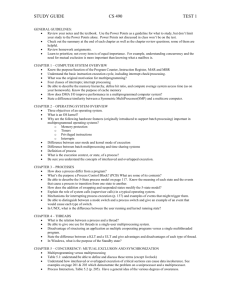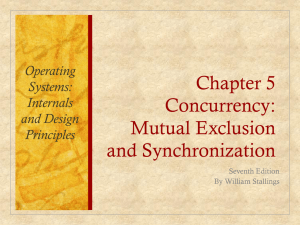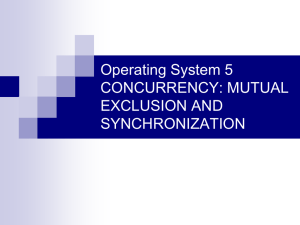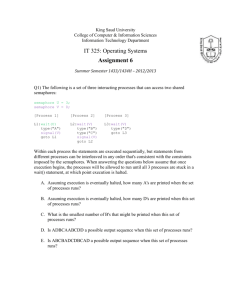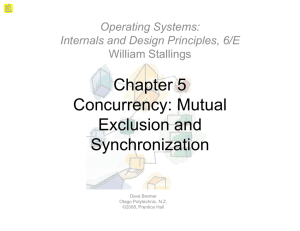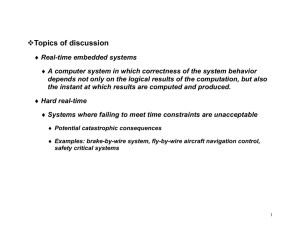TDDD82 Secure Mobile Systems Systems Software Lecture 2: Mutual exclusion,
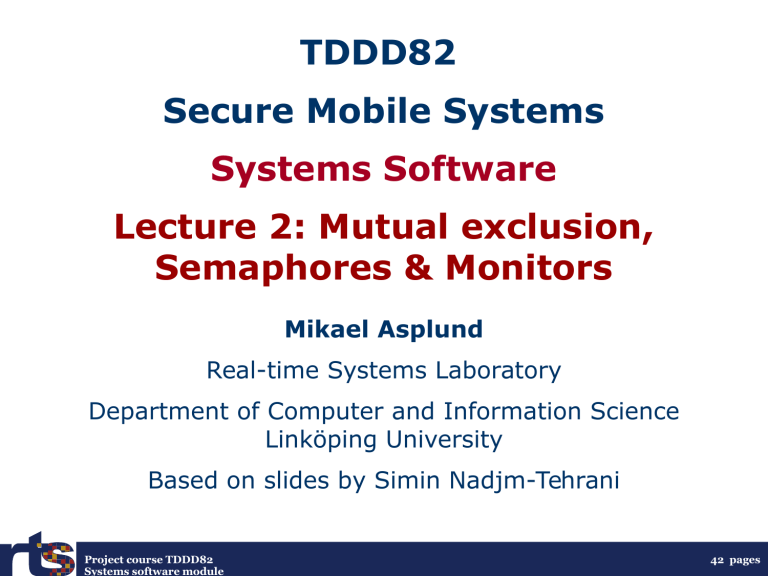
TDDD82
Secure Mobile Systems
Systems Software
Lecture 2: Mutual exclusion,
Semaphores & Monitors
Mikael Asplund
Real-time Systems Laboratory
Department of Computer and Information Science
Linköping University
Based on slides by Simin Nadjm-Tehrani
Project course TDDD82
Systems software module
42 pages
From last lecture
• How did it go with the exercise?
Process P1
X = 3;
Y = 0;
If (Y > 1) {
X = X - 1
} else {
X = X + 2
}
Process P2
X = 3;
Y = 2;
If Y < 1 {
X = X + 1
} else {
X = X – 2
}
Project course TDDD82
Systems software module
2 of 42
Lecture 1-3 Topics
• Processes, threads, and their representation
• Concurrency and execution
• Communication
• Synchronisation
• Solutions to mutual exclusion problem (ME)
• Support in operating system: semaphores
• Support in runtime system: monitors
• Deadlock and related issues
Project course TDDD82
Systems software module
3 of 42
Atomic update & ME
• Atomic: an operation that is always performed without interruptions
• To ensure that a single process updates a shared (complex) data structure at any time the application needs to manage the mutual exclusion problem!
Project course TDDD82
Systems software module
4 of 42
Mutual exclusion
• Consider n processes that need to exclude concurrent execution of some parts of their code
Process Pi {
entry-protocol
critical-section
exit-protocol
non-critical-section
}
• Fundamental problem to design entry and exit protocols for critical sections
Project course TDDD82
Systems software module
5 of 42
Process A while true {
…
X = X+1
Z = X^2
…
}
Critical section: example
Process B while true {
… if ((X mod 2)==0){
print(X)
}
print(Z)
…
}
Project course TDDD82
Systems software module
6 of 42
First attempt
Process P1 while true {
flag1 = up while (flag2 == up) {
do nothing (* busy waiting *)
}
critical-section
flag1 = down
non-critical-section
}
Project course TDDD82
Systems software module
[Dijkstra 1965]
7 of 42
Process P1 while true {
} while (flag2 == up) {
do nothing (* busy waiting *)
flag1 = up
critical-section
flag2 = down
non-critical-section
}
Second attempt
Project course TDDD82
Systems software module
8 of 42
Process P1 while true { while (turn == 2) {
do nothing (*busy waiting*)
}
critical-section
turn = 2
non-critical-section
}
Project course TDDD82
Systems software module
Third attempt
9 of 42
Process P1 while true { flag1 = up turn = 2 while (flag2 == up) and
(turn == 2) {
do nothing
} critical-section flag1 = down non-critical-section
}
Peterson’s algorithm
Process P2 while true {
flag2 = up
turn = 1 while (flag1 == up) and
(turn == 1) {
do nothing
}
critical-section
flag2 = down
non-critical-section
}
Project course TDDD82
Systems software module
10 of 42
Peterson’s algorithm
1A
1B
1C
Process P1 while true { flag1 = up turn = 2 while (flag2 == up) and
(turn == 2) {
do nothing
} critical-section flag1 = down non-critical-section
}
2A
2B
2C
Process P2 while true {
flag2 = up
turn = 1 while (flag1 == up) and
(turn == 1) {
do nothing
}
critical-section
flag2 = down
non-critical-section
}
Project course TDDD82
Systems software module
11 of 42
Summary of early solutions
• Implementing synchronisation and concurrency with shared variables, using only sequential programming constructs, is difficult and error prone
• Busy waiting solutions to mutual exclusion problems are:
– Difficult to implement - consider n processes instead of 2 in the Peterson solution!
– Wasteful for the CPU as a resource
• But...
– They do not require any support
Project course TDDD82
Systems software module
12 of 42
Programming language support
• Would be useful to have support from an operating system or a programming language
• Some programming languages have explicit support:
– Java: Early versions used Suspend/Resume constructs that led to race condition!
– Now java.util.concurrency provides good support.
– Ada: built-in run-time support with explicit task synchronisation entry points (Rendezvous)
Project course TDDD82
Systems software module
13 of 42
Next: more support
• How can the mutual exclusion and synchronisation problems be solved with other constructs?
– Semaphore and monitor
• What do we gain by using the support in
OS or programming language?
Project course TDDD82
Systems software module
14 of 42
Lecture 1-3 Topics
• Processes, threads, and their representation
• Concurrency and execution
• Communication
• Synchronisation
• Solutions to mutual exclusion problem (ME)
• Support in operating system: semaphores
• Support in runtime system: monitors
• Deadlock and related issues
Project course TDDD82
Systems software module
15 of 42
Recall from last lecture
Two general problems:
• Mutual exclusion
Process Pi { entry-protocol critical-section exit-protocol non-critical-section
}
• Condition synchronisation
Ex: Compute the interest when all cashpoint transactions have been processed
Project course TDDD82
Systems software module
16 of 42
Semaphores
• A semaphore S is a non-negative integer variable on which only two operations wait and signal can be performed wait (S) if S > 0 then S = S-1 else suspend the process calling wait(S) signal (S) if some process P has been suspended by an earlier wait(S), then wake up P else S = S+1
Project course TDDD82
Systems software module
17 of 42
Process Pi var mex: semaphore (* initially 1 *) while true {
wait(mex)
critical_section
signal(mex)
non_critical_section
}
Mutual exclusion
Project course TDDD82
Systems software module
18 of 42
Food for thought
Questions:
• How does the program behave with initial value 0 for the semaphore?
• If there are two processes, what is the maximum value of mex?
• If there are n processes?
Project course TDDD82
Systems software module
19 of 42
Counting semaphores
• When more than one instance of a resource is available, e.g. print servers
• Processes can use up to max available but no more
• The semaphore can be initialised to provide access for n processes
Project course TDDD82
Systems software module
20 of 42
Recall: two general problems
●
Mutual exclusion
Process Pi { entry-protocol critical-section exit-protocol non-critical-section
}
• Condition synchronisation
Ex: Compute the interest when all cashpoint transactions have been processed
Project course TDDD82
Systems software module
21 of 42
Condition synchronisation var condition:semaphore (* initially 0*) process P1 (* waiting process *)
...
wait (condition)
...
process P2 (* signalling process *)
...
signal (condition)
...
Project course TDDD82
Systems software module
22 of 42
Semaphore implementations
• Wait and Signal are implemented (by the operating system) as atomic operations
• Semaphore variable is always initialised as non-negative
But
• Which process to wake up among all suspended ones is not specified
Project course TDDD82
Systems software module
23 of 42
Atomicity: alternatives
• For programmer wait and signal are atomic (indivisible) operations
• In the supporting environment:
– allowing only one wait/signal to operate on a semaphore at any one time e.g. by
See
Siberschatz
Chapter 6.4
• disabling interrupts during execution
• busy waiting on entry to semaphore
• hardware support (e.g. test-and-set operations) for locking before wait/signal
Project course TDDD82
Systems software module
24 of 42
Semaphore implementations
• Wait and Signal are implemented as atomic operations
• Semaphore is always initialised as nonnegative
But
• Which process to wake up among all suspended ones is not specified
Project course TDDD82
Systems software module
25 of 42
Queue implementations
Process P1
… wait
…
(s) signal (s)
…
Process P2
… wait (s)
… signal (s)
…
One queue/semaphore at run-time:
Project course TDDD82
Systems software module
Process P3
… wait (s)
… signal (s)
…
26 of 42
Originally: Spin locks
• The original definitions of wait & signal just used a version of busy waiting to implement the semaphore: wait (s): while s ≤ 0 do nothing;
s = s-1 signal (s): s = s+1
Project course TDDD82
Systems software module
27 of 42
Semaphores vs. Busy waiting
• For long critical sections, semaphores
(that use a queue) more efficient in using CPU
• Better code organisation, less errors?
• What about problems with deadlock and starvation?
• We will come back to these ...
Project course TDDD82
Systems software module
28 of 42
Before next lecture: Exercise
Process A Process B while true { while true {
print(A) print(T)
print(K) print(C)
} }
Insert semaphores so that a sequence of
“TACK”s is printed out.
Project course TDDD82
Systems software module
29 of 42
Lecture 1-3 Topics
• Processes, threads, and their representation
• Concurrency and execution
• Communication
• Synchronisation
• Solutions to mutual exclusion problem
• Support in operating system: semaphores
• Support in runtime system: monitors
• Deadlock and related issues
Project course TDDD82
Systems software module
30 of 42
What is a monitor?
• A programming abstraction consisting of:
– A data structure on which programmer can define operations – which can only be run one at a time
– Condition variables for synchronisation
• Encapsulates shared data that several processes can operate upon
• All access is with mutual exclusion
• Pre object-orientation!
[Hoare 74]
Project course TDDD82
Systems software module
31 of 42
Project course TDDD82
Systems software module
Shared data
Condition variables X, Y
Operations on
Shared data
Initialisation code
Overview
32 of 42
Condition variables
•
• Declared as special synchronisation variables:
Condition X;
With two designated operations:
Don’t mix up these operations with Semaphore operations!
wait (X): suspend the calling process signal (X): if there are suspended processes on this variable, wake one up
Project course TDDD82
Systems software module
33 of 42
Example: Bounded buffer
(* in some language that supports monitors *) monitor BoundedBuffer {
Buf: array [0..SizeOfBuffer] of integer
Base, Top: integer
Count: integer
NotFull, NotEmpty: condition
operation Append(E: integer ) {
...
}
operation Take(E: integer ) {
...
}
begin
<initialize> (* set Base,Top,Count to 0 *)
}
Project course TDDD82
Systems software module
34 of 42
operation Append (E: integer ) {
if ( Count == SizeOfBuffer + 1) {
wait (NotFull)
}
Buff[Top] = E
Top = (Top + 1) mod SizeOfBuffer
Count = Count + 1
signal (NotEmpty)
}
Operation Append
Project course TDDD82
Systems software module
35 of 42
operation Take (E: integer ) {
if (Count == 0) {
wait (NotEmpty)
}
E = Buff[Base]
Base = (Base + 1) mod SizeOfBuffer
Count = Count - 1
signal (NotFull)
}
Operation Take
Project course TDDD82
Systems software module
36 of 42
Producer-Consumer problem
Process Producer var Element: integer while true {
Produce(Element)
Append(Element)
}
Process Consumer var Element: integer while true {
Take(Element)
Consume(Element)
}
Project course TDDD82
Systems software module
37 of 42
Observations
• Programmer uses wait and signal inside the code that applies the operations on the shared data structure
Note:
• The condition variable has no values assigned to it
• The queue associated with each variable is the main synchronisation mechanism
• Different semantics from semaphore operations for wait and signal
Project course TDDD82
Systems software module
38 of 42
Process queues
Queue of processes wanting to execute some monitor operation
These operations may use wait/signal on X, Y
Shared data
Condition variables X, Y
X:
Y: queue of processes waiting for X queue of processes waiting for Y
Operations on
Shared data
Initialisation code
Project course TDDD82
Systems software module
39 of 42
How does it work?
Process P1
… wait(X)
Process P4
… signal(X)
Process P2
… t
Which process to run at time t?
Project course TDDD82
Systems software module time
40 of 42
Options
• Original Hoare monitor: let the woken up process (P1) continue
What if there are several processes waiting on X?
• Pragmatic solution (Java): let the signalling process continue, and wake up P1 once P4 is suspended/exits
P1 has to check for condition X when woken up!
Project course TDDD82
Systems software module
41 of 42
Summary
• Monitors have the same goal as semaphores but are at a higher level of abstraction
– Exercise: Try implementing producerconsumer solution with semaphores!
• Monitor has two different mechanisms, one for handling synchronisation and one for data sharing
• Mutually exclusive access to data is automatic, but matching waits and signals still a problem!
Project course TDDD82
Systems software module
42 of 42
Android concurrency
• Uses java concurrency library
• One Linux process per application
–
One or more threads
–
Used for background tasks
UI thread
BG BG BG
Project course TDDD82
Systems software module
43 of 42
Android thread communication
• Message passing!
• UI thread runs a Loop that processes messages
Invoke message handler for M1
M1
M2
M3
M4
M5
Project course TDDD82
Systems software module
44 of 42
Java concurrency
• Low level basic notions:
–
–
–
– java.lang.Thread
volatile synchronized
Object.wait(), Object.notify()
• Not so easy to use!
Project course TDDD82
Systems software module
45 of 42
Java high level concurrency
• java.util.concurrency
–
–
–
Semaphores
Executor
Concurrent data structures
• For example, bounded buffer:
– java.util.concurrent.ArrayBlockingQueue<E>
Project course TDDD82
Systems software module
46 of 42
Java concurrency
• Low level basic notions:
–
–
– java.lang.Thread
volatile synchronized
• Avoid using these directly
Project course TDDD82
Systems software module
47 of 42
Java concurrency
• Low level basic notions:
–
–
– java.lang.Thread
volatile synchronized
• Avoid using these directly
Project course TDDD82
Systems software module
48 of 42
